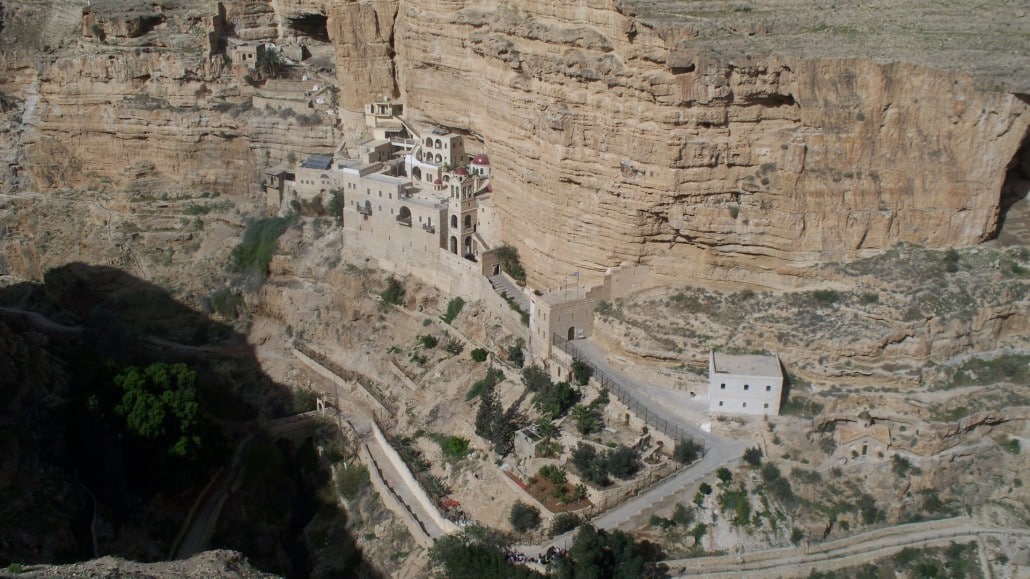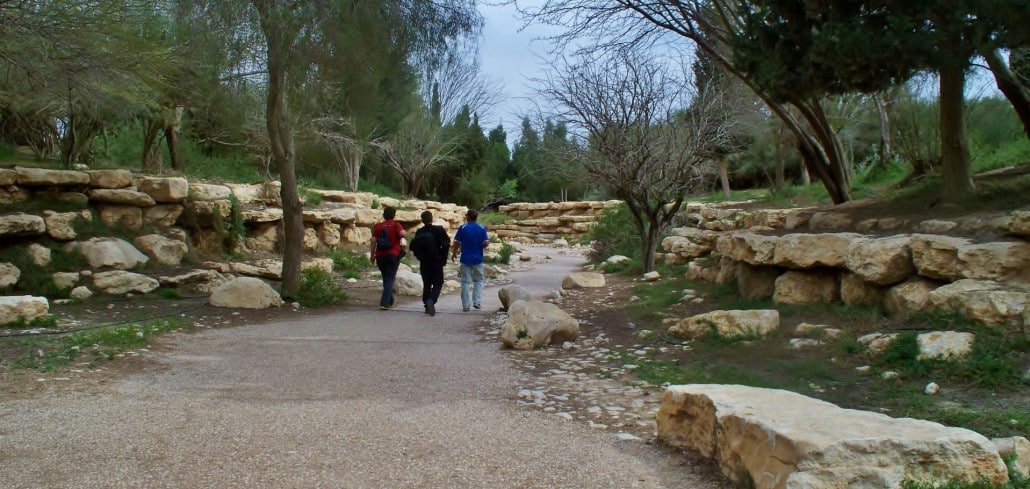
Leaving Jerusalem after a two-and-a-half-day visit brought some regrets (it proved an all-too-short stay), but the drive south, with the promise of visiting other renowned places, also brought anticipated excitement.
I didn’t have to wait long for my first adventure. Just a few miles out of Jerusalem, our guide asked if we’d like to see something extraordinary not included on the official itinerary. His proposal got a unanimous “yes” vote from me and my two companions.

St. George Monastery
Just a few twists and turns along a side road brought us to a spot where a dozen or so Bedouins coaxed and cajoled the tourist crowd into buying some of their goods. One aggressive entrepreneur, hoping to make a sale, even wrapped a turban-like scarf around my head as an inducement.
I wore the garment as our group walked around the opposite end of the hillside where a majestic vista opened onto a deep canyon. From our lofty perch, we looked down and could see the ancient St. George Monastery perched precariously on a cliff on the other side of the Kelt River Canyon. The monastery dates back to the fourth century when a group of monks decided they wanted to replicate the desert life of the Biblical prophets. The spot they chose is believed to be the valley of Psalm 23 fame (“though I walk through the darkest valley”) and the cave where ravens fed the prophet Elijah.
Destroyed by Persian invaders in 614 AD, the monastery was reborn starting in 1878 during a rebuilding project by a Greek monk who finished his work in 1901. Today, the cliff-hanging complex of buildings is occupied by a small group of Eastern Orthodox monks who are supported, in part, by the tourists who cross the canyon over a small pedestrian bridge.
Ein Gedi Nature Reserve
Further south, we put on our hiking boots at Ein Gedi Nature Reserve, just about an hour’s drive from Jerusalem. Thought to be the site where David hid from King Saul (Samuel 24:1-2), Ein Gedi, billed as one of the most beautiful places in Israel, has nine different hiking trails with a wide range of difficulty.
Our group took the lower section of the King David Wadi Trail, a circular route that leads past King David’s waterfall and takes roughly an hour to complete. The upper section is hiked over steeper, more challenging terrain and takes about 3-4 hours from start to finish.

Masada
The story behind Masada is almost as interesting as the site itself. Built as a fortress by King Herod between 37 and 31 BC, Masada is a tall, mesa-like mountain with sheer cliffs, some up to 1,300-feet high. Seventy-five years after Herod’s death, Jewish rebels fled to Masada at the end of the first war with Rome. A Roman army of 10,000 (some say 15,000) besieged the fort and managed to breach its walls, but only after a two-year siege.
To prevent the Romans from enslaving the nearly 1,000 defenders and their kinsfolk, the leaders drew lots to see which would be assigned the onerous duty of killing their wives, children and fellow soldiers. These would then slaughter those remaining, and the sole survivor would commit suicide by falling on his own sword.

Today, two narrow footpaths lead from the bottom to the top of Masada, one of the most visited tourist sites in Israel. As a less strenuous option, visitors can also take a cable car to and from the top where dramatic views of the Dead Sea contribute to the awe factor of the site. The ruins of much of Masada’s architectural history (Herod’s two palaces, a storehouse, cisterns, a synagogue, and bathhouse) can still be seen at what became a UNESCO World Heritage Site in 2001.

Rappelling in the Negev Desert
We used Mitzpe Ramon, a small village in the Negev Highlands, as our base to explore by jeep the nearby Ramon makhtesh—a large and unusual oval-shaped crater—and do some chaperoned rappelling from the town’s nearby cliffs. Unlike other craters, Makhtesh Ramon wasn’t formed by a volcano eruption or meteor strike, but instead by water erosion that carved out the inside of the crater. Arid and austere, yet beautiful, the makhtesh is part of Israel’s largest national park, the Ramon Nature Reserve.
We began our Negev adventures one morning in the company of guide Alen Gafny, an energetic, physically imposing man who offers rappelling adventures and jeep tours through the crater. After gearing up, my traveling companions braved the cliff heights, tethered to ropes, and, under Gafny’s watchful eye, bravely “hopped and jumped” down the cliff’s vertical face, a vertiginous escapade not for the feint of heart.

Adrenaline stoked, we then boarded Gafny’s jeep and bumped our way along the seemingly impassable roads into the heart of the crater. As he explained the makhtesh’s fascinating geological history, we listened, soaking in the diversity of rock colors and unusual formations and even stopping for an impromptu archery exercise.

A kibbutz, a winery with guest cabins and Ein Avdat National Park
Later, on the way to Ein Avdat National Park, we stopped for a look at one of Israel’s many wineries. Carmey Avdat, a family-run farm that includes lodging in guest cabins, has been producing wines since 2002 under some of the world’s most extreme grape-growing conditions. The terroir seems to come through to the glass, however, as the winemaker claims his wines have the unique aroma and flavor of the Negev. As tribute to his winemaking skills, his Merlots have won gold medals at Eshkol HaZahov, Israel’s top wine competition.

On our way north to Tel Aviv, we made a stop at Kibbutz Sde Boker, retirement home of former prime minister David Ben-Gurion, who resided there during his term of office and afterward. The wooden house where he lived has since become a museum, and, after his death in 1973, he was buried in an imposing grave next to his wife Paula on the kibbutz grounds.

Nearby, Ein Avdat is a beautiful canyon, encompassed by a national park with an undeniable allure for hiking, nature lovers and photography junkies. Two entrances, one at the bottom and another at the top, are a ten-minute drive apart.
If you’d prefer to hike the canyon, begin at the northern or lower entrance, the route that takes visitors to a beautiful, 50-foot waterfall. A small and narrow stone stairway covers part of the route, but the trail gets even more challenging beyond the waterfall where a metal staircase and ladders have been installed for easier access to the very top.
The ride south from Jerusalem was a real eye-opener as I began to realized that, besides its Biblical and historical riches, Israel also has a fair share of natural wonders. Combining the two during my weeklong visit proved a energizing mix, a yin-and-yang blend of adventure tourism and holy place/historic site exploration.
In Part 3: Tel Aviv and Jaffa. For the series homepage, click here.
For more information on Israel, log onto visitisrael.com.
